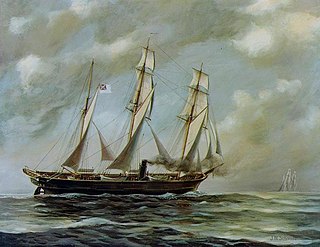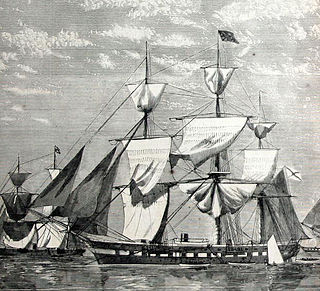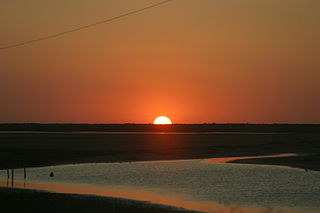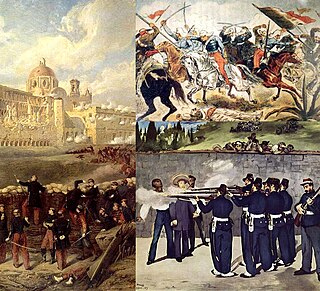 W
WThe Alabama Claims were a series of demands for damages sought by the government of the United States from the United Kingdom in 1869, for the attacks upon Union merchant ships by Confederate Navy commerce raiders built in British shipyards during the American Civil War. The claims focused chiefly on the most famous of these raiders, the CSS Alabama, which took more than sixty prizes before she was sunk off the French coast in 1864.
 W
WAlexander Nevsky was a large screw frigate of the Russian Imperial Navy. The ship was designed as part of a challenge being offered by the Russian Empire to the Royal Navy, but was lost in a shipwreck in 1868 while Grand Duke Alexei, son of Tsar Alexander II, was aboard.
 W
WDespite being across the world from the conflict, the Australian colonies were affected by the American Civil War both economically and by immigration. The Australian cotton crop became more important to England, which had lost its American sources, and it served as a supply base for Confederate blockade runners. Immigrants from Europe seeking a better life also found Australia preferable to war-torn North America.
 W
WBagdad, Tamaulipas, Mexico was a town established in 1848 on the south bank of the mouth of the Río Grande. This town is also known as the Port of Bagdad or the Port of Matamoros, since it is inside the municipality of Matamoros, Tamaulipas. Officially declared non-existent in 1880, it is now invisible, covered by the shifting sands of time.
 W
WDespite being a territory of the British Empire, the Bahamas was affected by the American Civil War. Much as it was during the Golden Age of Piracy, the Bahamas was a haven for swashbucklers and blockade runners that were aligned with the Confederate States. Although Florida is only 55 miles away, the state then had few ports of any real consequence and so blockade runners would make their trips from Nassau to Charleston, South Carolina, the largest Confederate port on the East Coast.
 W
WThe Chesapeake Affair was an international diplomatic incident that occurred during the American Civil War. On December 7, 1863, Confederate sympathizers from the Maritime Provinces captured the American steamer Chesapeake off the coast of Cape Cod. The expedition was planned and led by Vernon Guyon Locke (1827–1890) of Nova Scotia and John Clibbon Brain (1840–1906). When George Wade of New Brunswick killed one of the American crew, the Confederacy claimed its first fatality in New England waters.
 W
WConfederate colonies were made up of refugees from the Confederate States of America who fled the United States after the latter won the American Civil War (1861–1865). They settled in many countries, especially Brazil, and to a lesser extent Mexico.
 W
WThe American Civil War (1861–1865) drew considerable international attention from both governments and the general public, as it involved one of the world's nascent powers and centered on the globally divisive issue of slavery. Consequently, many men enlisted from abroad and among immigrant communities in the United States. When hostilities first broke out, roughly 13% of Americans were foreign-born, the vast majority concentrated in northern cities; subsequently, foreign enlistment in the American Civil War largely favored the Union, which was far more successful at attracting international volunteers.
 W
WThe Second French Empire remained officially neutral throughout the American Civil War and never recognized the Confederate States of America. The United States warned that recognition would mean war. France was reluctant to act without British collaboration, and the British government rejected intervention.
 W
WThe Lancashire Cotton Famine, also known as the Cotton Famine or the Cotton Panic (1861–65), was a depression in the textile industry of North West England, brought about by overproduction in a time of contracting world markets. It coincided with the interruption of baled cotton imports caused by the American Civil War and speculators buying up new stock for storage in the shipping warehouses at the entrepôt.
 W
WJames Murray Mason, a grandson of George Mason, was a lawyer, slaveholder, and politician. He served as senator from Virginia, having previously represented Frederick County, Virginia, in the Virginia House of Delegates.
 W
WThe relations between the Russian Empire and the United States of America (1776–1917) predate the Soviet Union–United States relations (1922–1991) and the modern Russia–United States relations (1991–present). Relations between the two countries were established immediately after the US declared its independence.
 W
WThe Second French Intervention in Mexico, 1861–1867; was an invasion of Mexico, launched in late 1861, by the Second French Empire (1852–1870), aiming to establish in Mexico a regime favorable to French interests.
 W
WThe Trent Affair was a diplomatic incident in 1861 during the American Civil War that threatened a war between the United States and the United Kingdom. The U.S. Navy captured two Confederate envoys from a British Royal Mail steamer; the British government protested vigorously. The United States ended the incident by releasing the envoys.
 W
WThe Uragan class was a class of monitors built for the Baltic Fleet of the Imperial Russian Navy. The ships were built to the plans of the American Passaic-class monitors, a design that was tested on a smaller scale on USS Monitor. A total of 10 ships were constructed at five different shipyards in Saint Petersburg, all entering service in 1865. The ships were among the first ironclad warships in the Russian Navy.